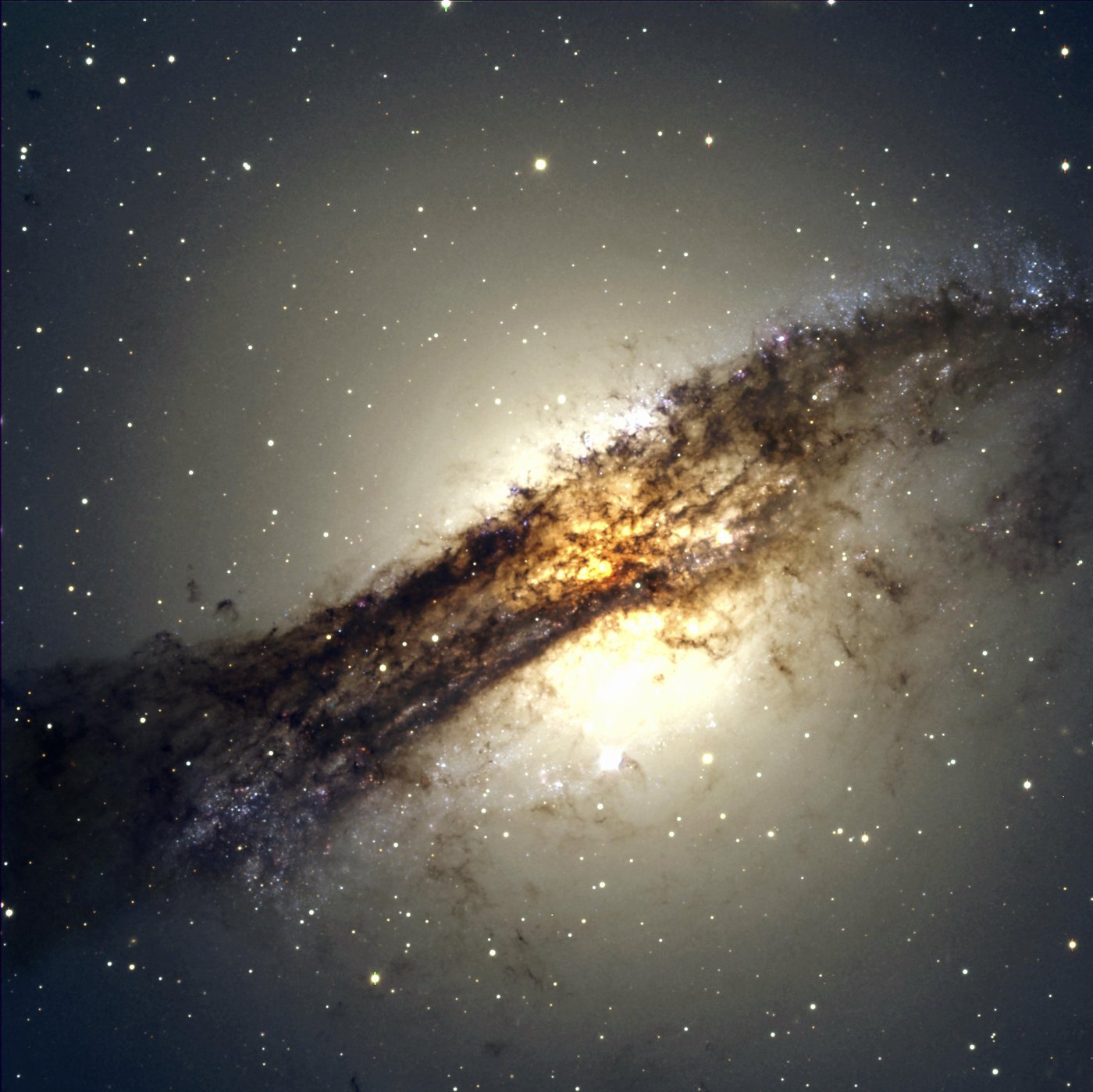Welcome back to Constellation Friday! Today, in honor of the late and great Tammy Plotner, we will be dealing with the “Centaur”, the Centaurus constellation!
In the 2nd century CE, Greek-Egyptian astronomer Claudius Ptolemaeus (aka. Ptolemy) compiled a list of all the then-known 48 constellations. This treatise, known as the Almagest, would be used by medieval European and Islamic scholars for over a thousand years to come, effectively becoming astrological and astronomical canon until the early Modern Age.
One of these is the famous Centaur of classical antiquity, otherwise known as the constellation Centaurus. As one of the 48 constellation included in the Almagest, it is now one of the 88 modern constellations recognized by the IAU. Located in the southern sky, this constellation is bordered by the Antlia, Carina, Circinus, Crux, Hydra, Libra, Lupus, Musca, and Vela constellations.
Name and Meaning:
In classic Greco-Roman mythology, Centaurus is often associated with Chiron the Centaur – the wise half-man, half-horse who was a teacher to both Hercules and Jason and the son of the Titan king Cronus and the sea nymph Philyra. According to legend, Cronus seduced the nymph, but they were interrupted by Cronus’ wife Rhea. To evade being caught in the act, Cronus turned himself into a horse.

As a result, Philyra gave birth to a hybrid son. He died a tragic death in the end, having been accidentally struck by one of Heracles’ poisoned arrows. As an immortal god, he suffered terrible pains but could not die. Zeus eventually took pity on the centaur and released him from immortality and suffering, allowing him to die, and placed him among the stars.
It is believed that the constellation of Sagitta is the arrow which Chiron fired towards Aquila the Eagle to release the tortured Prometheus. The nearby constellation of Lupus the Wolf may also signify an offering of Hercules to Chiron – whom he accidentally poisoned. Just as Virgo above represents the maid placed in the sky as a sign of pity for the Centaur’s plight.
History of Observation:
The first recorded examples of Centaurus date back to ancient Sumeria, where the constellation was depicted as the Bison-man (MUL.GUD.ALIM). This being was depicted in one of two ways – either as a four-legged bison with a human head, or as a creature with a human head and torso attached to the rear legs of a bison or bull. In the Babylonian pantheon, he was closely associated with the Sun god Utu-Shamash.
The Greek depiction of the constellation as a centaur is where its current name comes from. Centaurus is usually depicted as sacrificing an animal, represented by the constellation Lupus, to the gods on the altar represented by the Ara constellation. The centaur’s front legs are marked by two of the brightest stars in the sky, Alpha and Beta Centauri (aka. Rigil Kentaurus and Hadar), which also serve as pointers to the Southern Cross.

In the 2nd century AD, Ptolemy catalogued 37 stars in the constellation and included it as one of the 48 constellations listed in the Almagest. In 1922, it was included in the 88 modern constellations recognized by the International Astronomical Union (IAU).
Notable Features:
Centaurus contains 11 main stars, 9 bright stars and 69 stars with Bayer/Flamsteed designations. Its brightest star – Alpha Centauri (Rigel Kentaurus) – is the Solar System’s closest neighbor. Located just 4.365 light years from Earth, this multiple star system consists of a yellow-white main sequence star that belongs to the spectral type G2V (Alpha Centauri A), and a spectral type K1V star (Alpha Centauri B).
Alpha Centauri A, the brightest component in the system, is the fourth brightest individual star (behind Arcturus) in the night sky, B is the 21st individual brightest star in the sky. Taken together, however, they are brighter than Arcturus, and rank third among the brightest star system (behind Sirius and Canopus). The two stars are believed to be roughly the same age – ~4.85 billion years old – and are close in mass to our Sun.
Proxima Centauri, a red dwarf system (spectral class M5Ve or M5Vie), if often considered to be a third member of this star system. Located about 0.24 light years from the binary pair (and 4.2 light years from Earth), this star system was confirmed in 2016 to be home to the closest exoplanet to Earth (Proxima b).
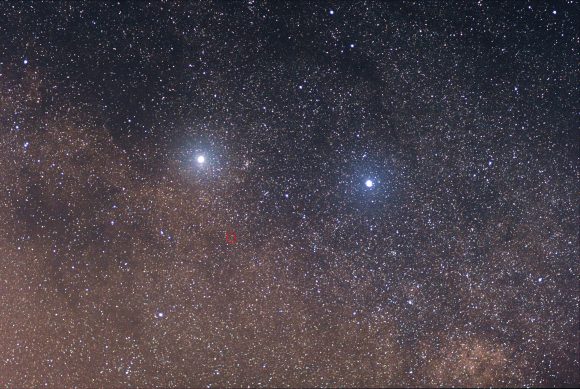
Then there’s Beta Centauri, a blue-white giant star (spectral class B1III) located 348.83 light years from Earth that is the tenth brightest star in the sky. The star’s traditional names (Hadar or Agena), are derived from the Arabic words for “ground” and “the knee”, respectively. This multiple star system consists of Hadar A, a spectroscopic binary of two identical stars, while Hadar B orbits the primary pair with a period of at least 250 days.
Next up is Theta Centauri (aka. Menkent), an orange K-type giant (spectral class K0IIIb) that is located approximately 60.9 light years from Earth. Its traditional name, which comes from its location in the constellation, translates to “shoulder of the Centaur” in Arabic.
And then there’s Gamma Centauri (Muhlifain), a binary star system located 130 light years from Earth which is composed of two stars belonging to the spectral type A0. It’s name is translated from Arabic and means “two things”, or the “swearing of an oath”, which appears to be a case of name-transfer from Muliphein, a star located in the Canis Majoris constellation.
The constellation is also home to many Deep Sky Objects. For instance, there is the Centaurus A galaxy, the fifth brightest galaxy in the sky and one of the closest radio galaxies to the Solar System (between 10 and 16 million light years distant). The galaxy has an apparent visual magnitude of 6.84 and is believed to contain a supermassive black hole at its center.
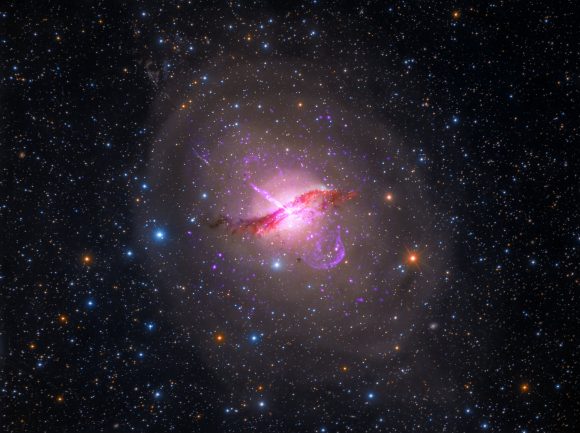
Centaurus A’s brightness is attributed to the intense burst of star formation going on inside it, which is believed to be the result of it undergoing a collision with a spiral galaxy. Centaurus A is located at the center of the Centaurus A subgroup of the Centaurus A/M83 Group of galaxies, which includes the Southern Pinwheel Galaxy (aka. Messier 83, M83).
Then there’s the famous Omega Centauri globular cluster, one of the brightest globular clusters in the Milky Way. Located approximately 15,800 light years distant, this cluster is bright enough to be visible to the naked eye. Originally listed as a star by Ptolemy in the Almagest, the cluster’s true nature was not discovered until John Herschel studied it in the early 19th century.
Next up is NGC 4945, one of the brightest galaxies in the Centaurus A/M83 group, and the second brightest galaxy in the Centaurus A subgroup. The spiral galaxy is approximately 11.7 million light years distant and has an active Seyfert II nucleus, which could be due to the presence of a supermassive black hole at its center.
The galaxy NGC 4650A is also located in Centaurus, some 130 million light years from Earth. This galaxy is one of only 100 polar-ring galaxies known to exist, which are so-named because their outer ring of stars and gas rotate over the poles of the galaxy. These rings are believed to have formed from the gravitational interaction of two galaxies, or from a collision with a smaller galaxy in the past.
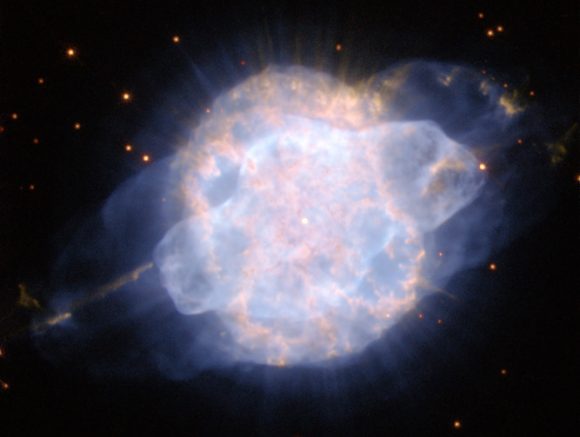
The Blue Planetary nebula (aka. the Southerner), is a bright planetary nebula in Centauru, approximately 4,900 light years distant. With an apparent visual magnitude of 8.5, it is the brightest planetary nebula in the far southern region of the sky and and can be observed in a small telescope.
Finding Centaurus:
Centaurus is one of the largest constellations in the night sky – covering over 1000 square degrees – and the brightest in the southern hemisphere. For observers located at latitudes between +30° and -90°, the entire constellation is visible and the northern portion of the constellation can be spotted easily from the northern hemisphere during the month of May.
For the unaided southern skies observer, the constellation of Centaurus holds a gem within its grasp – Omega Centauri (NGC 5139). But of course, this object isn’t a star – despite being listed on the catalogs as its Omega star. It’s a globular cluster, and the biggest and brightest of its kind known to the Milky Way Galaxy. Though visible to the naked eye, it is best observed through a telescope or with binoculars.
This 18,300 light-year beauty contains literally millions of stars with a density so great at its center the stars are less than 0.1 light year apart. It is possible Omega Centauri may be the remains of a galaxy cannibalized by our own. Even to this present day, something continues to pull at NGC 5139’s stars… tidal force? Or an unseen black hole?
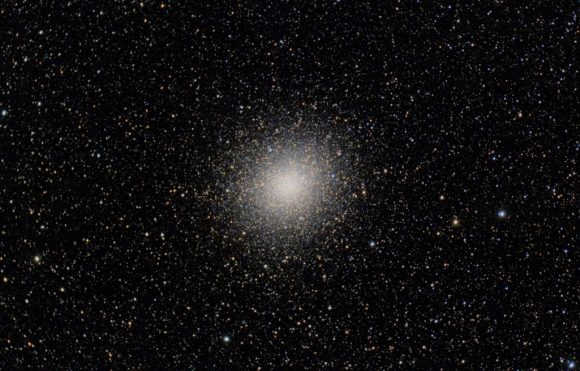
Now, hop down to Alpha. Known as Rigil Kentaurus, Rigil Kent, or Toliman, is the third brightest star in the entire night sky and the closest star system to our own solar system. To the unaided eye it appears a single star, but it’s actually a binary star system. Alpha Centauri A and Alpha Centauri B are the individual stars and a distant, fainter companion is called Proxima Centauri – a red dwarf that is the nearest known star to the Sun.
Oddly enough, Proxima Centauri is also a visual double, which is assumed to be associated with Centaurus AB pair. Resolution of the binary star Alpha Cen AB is too close to be seen by the naked eye, as the angular separation varies between 2 and 22 arc seconds, but during most of the orbital period, both are easily resolved in binoculars or small telescopes.
Then stop for a moment to take a look at Beta Centauri. Beta Centauri is well-known in the Southern Hemisphere as the inner of the two “Pointers” to the Southern Cross. A line made from the other pointer, Alpha Centauri, through Beta Centauri leads to within a few degrees of Gacrux, the star at the top of the cross. Using Gacrux, a navigator can draw a line with Acrux to effectively determine south.
But, that’s not all! Hadar is also a very nice double star, too. The blue-white giant star primary is also a spectroscopic binary, accompanied by a widely spaced companion separated from the primary by 1.3″. Or try Gamma Centauri! Muhlifain has an optical companion nearby, but check it out in the telescope… it’s really two spectral type A0 stars each of apparent magnitude +2.9!
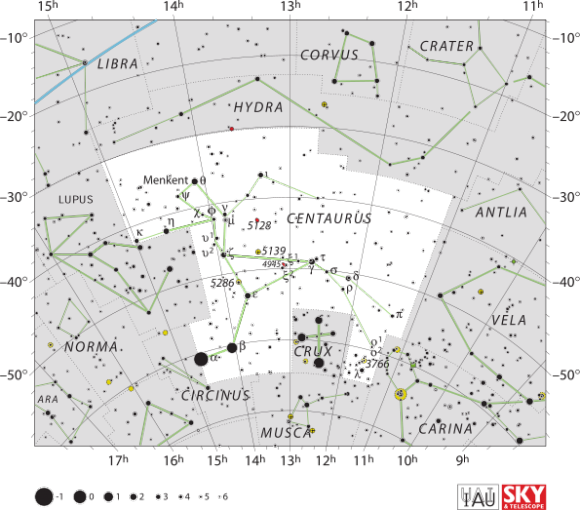
For binoculars or telescopes, hop on over to Centaurus A. This incredible radio source galaxy is one of the closest to Earth and also the fifth brightest in the sky. When seen through an average telescope, this galaxy looks like a lenticular or elliptical galaxy with a superimposed dust lane, and oddity first noted in 1847 by John Herschel.
The galaxy’s strange morphology is generally recognized as the result of a merger between two smaller galaxies and photographs reveal a jet of material streaming from the galactic core. Although we cannot see it, there may be a supermassive black hole at the center of the galaxy is responsible for emissions in the X-ray and radio wavelengths!
For binoculars and rich field telescopes, head towards the Crux border and center on Lambda Centauri for open cluster, IC2944. Also known on some observing lists as Caldwell 100, this scattered star cluster contains about 30 stellar members and some faint nebulosity. About 2 degrees southwest of Beta you’ll find another pair of open clusters, NGCs 5281 and 5316. Or try your hand just about a degree west of Alpha for open cluster, NGC5617. These last three are far more rich in stars and photon satisfying!
Centaurus has been known to human astronomers since the Bronze Age and has gone through some changes since that time. But even after thousands of years’ time, the Centaur is still hunting in the night sky! And for those who love viewing classic constellations and bright objects, it still provides viewing opportunities that are bound to dazzle the eyes and inspire the mind!
We have written many interesting articles about the constellation here at Universe Today. Here is What Are The Constellations?, What Is The Zodiac?, and Zodiac Signs And Their Dates.
Be sure to check out The Messier Catalog while you’re at it!
For more information, check out the IAUs list of Constellations, and the Students for the Exploration and Development of Space page on Canes Venatici and Constellation Families.
Sources:

